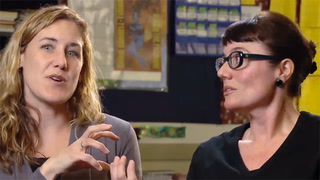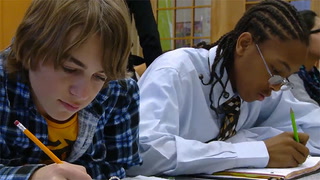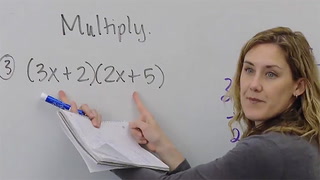Algebra Team - Inside Ms. Jones' Class with Julianna Jones
[01:00:14;25]
Julianna: "OK, so we're talking now, how do you factor a trinomial? If you're gonna go backwards, what's gonna happen here? Start with the answer. What do you mean by that?"
My enthusiasm is my style.
Student: "The number's already in the space."
Julianna: It's just who I am.
"We're gonna put some numbers in the box. What's that called, the inside of the box?"
Student: "The area."
Julianna: "OHHH! Please write this now."
I need my students to be engaged. Those minutes that we have together, I need them with me, and I demand that. You're here. I get to be your teacher right now. Let's do this together. And, and how do I hold your attention? And, how do I make you know that what you say matters? I mean, it really, really, matters.
"Wow! So, you see how you went down that list and then it was like "Bam!"? That's nice!"
"It's a little quiet. Let's talk. Let's talk about how you do that diamond. What are you gonna do? How do you multiply?"
We always start with a warm-up and, and partly that's to send the message that, like, the minute you walk in, you start doing mathematics.
"Let's go! What are you doing for this first one? What do you do with 60? How are we doing?"
Then, we checkin.
"So, I need one person to come up and put up their answer. They do not have to talk, and they do not have to be right. In fact, it's good if you're wrong. OK? Don't be like "Ugh. it's not right. I can't do it!" Come up, just put what you got up there. OK, Rosa's gonna start off."
I like to get students involved to see their work on the board, to see the way they organize their thinking.
"Rosa's gonna pick one of you to discuss it."
They have to mess around with it. They have to be active. It goes a lot faster if I do all the work for them, right? If I'm standing up there, and that's the only person talking, but um, I know that that's not the way students learn.
"You ready to go backwards?"
Students: "Yes!" "No!"
Julianna: "Yes! Yes! OK. So, go into your notes. Let's get it out. Here we are."
After we worked on the warm-up, we went into our notes, and that's when we're formalizing ideas.
"So what's different. Instead of giving you this, like the warm-up, we give you what's in the rectangle. What do you have to find?"
In general, my notes time is not lecture.
Student: "On the outside."
Julianna: "OK, so that's, that's exactly right. Now help it. Bring out, bring out that language. So, what is that stuff on the sides called?"
I want them to be involved. I want ideas to come from them.
Students: "The length and the width"
Julianna: "OK. The length and the width. If I just provide the right examples, and the right opportunities, they own it."
"Alright, let's do this! So, let me give you the inside. I got an X squared..."
In this case, we were just doing three examples.
"Negative 4x, negative 10x, negative 6x, and one."
So, the note time is just a time for them to sort of, do math, and then for me, and us, to record it.
"OK, you know I'm going to Fabian, because I haven't heard a lot from him."
I want them to be communicating mathematically.
"Where do you want that?"
The more that they talk mathematics, they're doing mathematics. But, getting them to make that connection is hard.
"Why do you think of this?"
Student: "I don't know."
Student: "Because you can multiply..."
Julianna: "You do know! You do know! Sh!! Sh!! You know I want him to talk!"
Student: "And then, when you finish it, it can be plus negative one."
Julianna: "OK, wait, why is this working? 2x plus.."
Student: "Negative one"
Julianna: "Because.."
Student: "That would make negative 2x"
Julianna: "OK. And you got this one too?"
Student: "Yeah, that's 1?"
Student: "Negative one"
Student: "Negative one. Right?"
Student: "Yeah"
Julianna: "And what about this guy?"
Student: "Uh, that's one"
Julianna: "Why?"
Student: "Negative one times negative one"
Julianna: "Bam! Love it!"
This is what understanding is about.
"Are you following this?"
You can do the problem. You can discuss the problem. You can explain exactly what's going on with appropriate vocabulary.
"How he multiplied. Did you hear how I was pushing him to say what times what makes what."
If you can do all those things, then you really understand it. And, if you can only do one piece of it, I'm not satisfied. I'm pushing for that deeper conceptual understanding.
"I love what I saw. I love how you worked. I'm really, really happy with that."
When students feel like they understand something then they're happy. And, if they're happy, you know, then, then we're, we're going back to the love of learning, and, and that's what I'm about.














5 Comments
Aundrea Gamble Apr 23, 2020 11:38am
1. How does Ms. Jones's warm-up differ from Ms. Warburton's?
Ms. Jones wants her students to interact with each other during the warm-up. She wants students to engage with each other to figure out how to solve the problem.
2. How does she engage students in reviewing the warm-up?
Ms. Jones engages the students by her enthusiasm during the warm-up.
3. How does Ms. J push students to converse with math vocabulary?
The more students talk mathmatics the more they understand mathmatics. She continues to push students by asking questions to gain a deeper understanding of their conceptual thinking.
Matthew Malvido Apr 25, 2019 10:40am
I am very pleased to see a math teacher embody such a level of energy in the classroom. I believe most math classes tend to be "dull," or disengaged, mostly due to the fact that the teacher is disengaged from the students. It's easy to see that Ms. Jones has connected with her students through her enthusiasm, and it allows students to be more comfortable in the class. My favorite part has to be the moment where Ms. Jones tells the student that he DOES know how he got his answer, and the reenforcement of telling students that they do in fact know is very important, because it has become more of a norm for students to believe that their answers come from "luck," or simply guessing. Thank you for sharing!
Gustavo Balladares Nov 22, 2017 1:01am
Felicia Oliver Dec 30, 2015 11:57pm
Joseph Lim Feb 15, 2012 2:05am